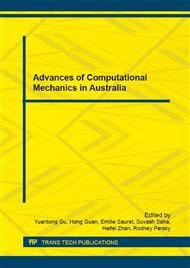p.541
p.547
p.553
p.559
p.565
p.571
p.577
p.583
p.589
Design and Fabrication of Structural Connections Using Bi-Directional Evolutionary Structural Optimization and Additive Manufacturing
Abstract:
The need to simplify the construction issues of complex structures leads to definition of SmartNodes project as a research which aims to confine the complexity of structure to a limited area (nodes) in order to decrease processing steps and labor intensity by application of additive manufacturing (AM) techniques. Bi-Directional Evolutionary Structural Optimization (BESO) is used to design efficient and elegant nodal connections of large scale spatial structures and minimise the volume of nodes to be printed and to ultimately replace welded, forged and cast connections by 3D printed connections. The prototypes discussed in this paper demonstrate BESO design process through two generic cases.
Info:
Periodical:
Pages:
571-576
Citation:
Online since:
July 2016
Authors:
Price:
Сopyright:
© 2016 Trans Tech Publications Ltd. All Rights Reserved
Share:
Citation:


